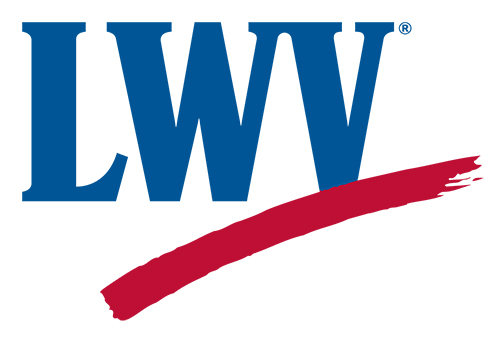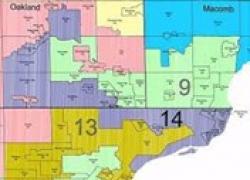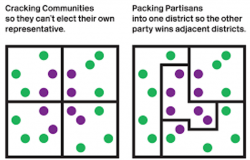
This year, Michigan will use a revolutionary new process for creating election districts for Congress and the state house and senate. This new method relies on broad public participation and employs a new concept: communities of interest. The League of Women Voters of Michigan, which promotes democracy and empowers voters, has two goals. First, to educate as many as possible about the new process, using virtual Town Halls across the state to describe the MICRC and to answer questions. Second, 100 LWVMI members are working to identify, contact, and support “communities of interest” state wide.
To find a Town Hall for your county, go to https://lwvmi.org/issues/redistricting.html. If you know of a “community of interest” and want more information or to ask for LWV support, write to league [at] lwvannarbor.com
“Redistricting” is the process of drawing the lines that determine the shape of, and people included in, election districts. The U.S. constitution requires this every 10 years, following the Census. “Gerrymandering” refers to partisan legislators drawing those lines to ensure their party continues to win.
According to voting experts at the Brennan Center at NYU, Michigan was one of the most severely gerrymandered states: while statewide elections such as the presidential one broke close to 50-50, elections for Congress and the state legislature widely favored Republicans, 9 or 8 to 5 or 6.
Gerrymandering uses two tools: “packing” voters with certain characteristics into a district, enabling them to elect one of their own but keeping them from affecting the vote in adjacent districts. Or “cracking” those voters, dividing them up among several districts in none of which they are a majority. A classic “packing” example is Michigan’s current 14th Congressional district, drawn to connect Detroit with Pontiac to create a district that is 79% Democratic and over 80% African American. “Packing” can lead to “cracking” when minority [e.g. Democratic] individuals not included in the “packed” district are put in adjacent districts in which their numbers are overwhelmed by the majority [e.g. Republicans]


The League of Women Voters of Michigan brought a federal lawsuit in 2017 against the Michigan Secretary of State, asking that the lines drawn in 2011 be declared unconstitutional and ordering the SOS to redraw the lines. The LWVMI won in federal district court, but the U.S. Supreme Court refused to consider the case, holding that the matter was “political” and therefore not within the Court’s jurisdiction.
In November, 2018, voters approved, by 61%, an amendment to the Michigan constitution that took redistricting out of the hands of the legislature, and put it in the hands of a new Independent Citizens Redistricting Commission (MICRC), which will draw new districts for Congress and for the state senate and legislature.The Michigan constitution cannot be changed by the Legislature alone; voters have to approve any change. The most important elements of the new process are designed to make impossible the kind of secret decision-making that lay behind the 2011 redistricting. These include: a randomly selected group of 13 commissioners, 4 Republicans, 4 Democrats, and 5 Independents, all registered to vote in Michigan and not having participated in electoral activities for the last 6 years; and requirements that all meetings be available for public observation and participation in the redistricting process.
The amendment also established funding to compensate commissioners and hire staff to support the commission, gave it the power to sue, required it to start work by October 15 (it started in September) and complete it by November 1, inform the public about its work, and hold at least 10 public hearings before drawing maps, and 5 after it has a map for each of the three types of district. The constitution specifies how the commission shall vote, requiring a majority (7 of the 13) for all decisions except map approval. Map approval requires a majority vote and the vote of at least two who affiliate with each major party and two who do not. If, after a regular vote and a ranked-choice vote, plans are tied for the highest point total, the secretary of state shall randomly select the final plan.
The amendment also provides seven prioritized criteria for district maps. First come federal laws, such as equal population, and compliance with the voting rights act and other federal laws. Second, that districts be geographically contiguous. Third—and this is brand new in Michigan—that districts reflect the state’s diverse population and communities of interest. These COI’s may include, but are not limited to, cultural or historical characteristics, or economic interests. Because election districts are geographic areas, a COI should occupy a contiguous area. A COI should also share interests in matters affected by legislation. Examples could include school districts, neighborhoods, or communities defined by natural resource features, as well as racial, ethnic, religious or language communities. The League of Women Voters is focused on identifying, contacting, and supporting these groups.
The other Constitutional requirements are that the districts not provide a disproportionate advantage to any political party; not favor or disfavor an incumbent or a candidate; shall reflect consideration of county, city, and township boundaries; and shall be reasonably compact. Look back at that map. Are districts “reasonably compact”?
The MICRC’s meetings are available while they meet, and afterwards. Minutes of meetings, agendas for current meetings, and all documents produced by the MICRC are available at https://www.michigan.gov/micrc
The 2020 Census data on which the MICRC will rely won’t be available until Sept. 30, making it impossible for the commission to finish by Nov. 1. It has asked the Michigan Supreme Court to extend the deadline.
The 61% of voters who accomplished this revolutionary change in how Michigan’s election districts are drawn may have forgotten what they did, or may not know the details, and may not appreciate how important it is to form an opinion about how you want your district drawn: who should it include, who should it exclude, and why. And these lines affect everyone—not just voters.
Anyone who is affected by state or federal legislation—which is everyone—should know about this new process and consider taking part in it.
--Margaret A. Leary, Member
League of Women Voters of the Ann Arbor Area